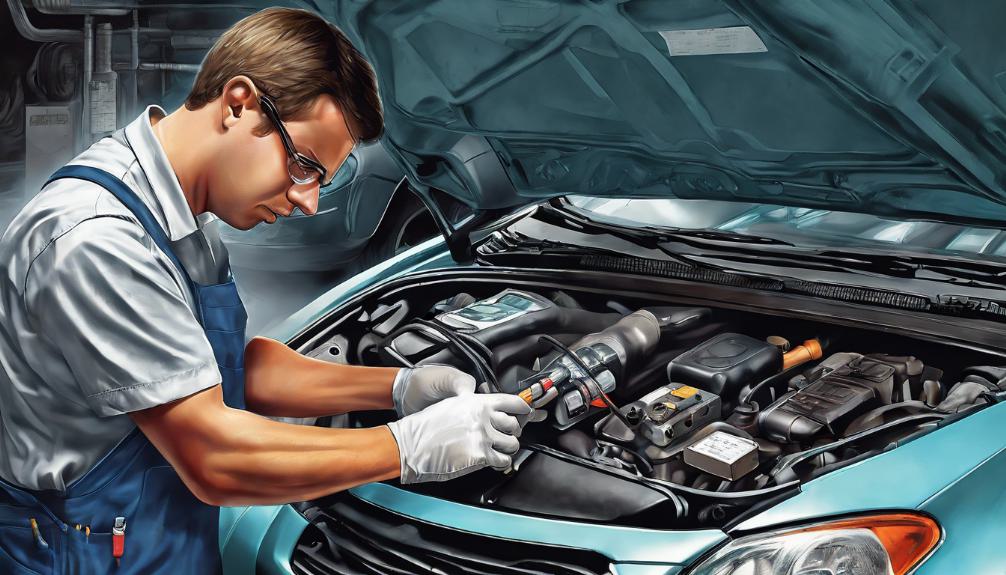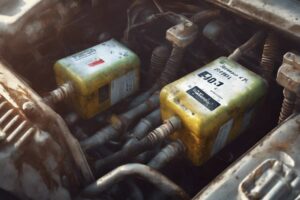If you’re dealing with a P0101 code linked to air flow sensor issues, start by using an OBD-II scanner for diagnostics.
Check the MAF sensor for cleaning and inspect the air filter, throttle body, and intake system. Calibrate the sensor and analyze airflow to pinpoint the problem accurately.
Confirm proper voltage and ground connections and assess the MAF sensor’s functionality to address performance concerns.
For long-term solutions, consider regular maintenance like cleaning your MAF sensor, following manufacturer recommendations, and verifying voltage and ground connections.
Mastering these steps will lead you to efficient troubleshooting techniques to resolve the P0101 code effectively.
Key Points
- Use OBD-II scanner for code retrieval.
- Check MAF sensor for dirt or contamination.
- Inspect intake system for leaks.
- Verify MAF sensor’s voltage and signal.
- Focus on sensor calibration and airflow analysis.
Common Symptoms of P0101 Code

If you notice your engine stalling or idling roughly, you may be experiencing common symptoms associated with the P0101 error code.
Engine performance issues like hesitation or lack of power during acceleration are often linked to air flow issues that trigger the P0101 fault.
This code typically points to problems with the air flow sensor, impacting the engine’s ability to regulate the air-fuel mixture accurately.
When the sensor fails to measure the incoming air properly, it can lead to decreased fuel efficiency and even black smoke coming from the exhaust.
Understanding these common symptoms can help you diagnose and address the P0101 code promptly. Monitoring your vehicle for signs like rough idling, stalling, or reduced power can signal potential air flow sensor issues.
By recognizing these indicators early on, you can take proactive steps to restore your engine’s performance and resolve any underlying air flow issues causing the P0101 error.
Potential Causes of P0101 Code
Addressing the potential causes of the P0101 code requires a thorough examination of key components like the Mass Air Flow (MAF) sensor and related systems. To pinpoint the issue, consider the following:
- MAF sensor cleaning: Over time, the MAF sensor can accumulate dirt and debris, affecting its accuracy in measuring air intake. Regular cleaning can help maintain its functionality and prevent triggering the P0101 code.
- Air filter inspection: A clogged or dirty air filter can disrupt the air-fuel mixture ratio, leading to incorrect readings by the MAF sensor.
Check that the air filter is clean and free from blockages to avoid potential issues with air intake measurement.
- Throttle body examination: The throttle body plays an important role in regulating airflow into the engine. Any malfunction in this component can impact the MAF sensor’s readings.
Check for any signs of wear, carbon buildup, or obstructions that could affect its performance.
Diagnostic Steps for P0101 Code

To diagnose the P0101 code effectively, start by using an OBD-II scanner to retrieve the code and related codes for accurate assessment.
Once you have the code, focus on sensor calibration and airflow analysis.
Inspect the Mass Air Flow (MAF) sensor for any dirt, debris, or contamination that could affect its performance. Check the intake system for leaks, cracks, or obstructions that might impact air flow readings.
Test the MAF sensor’s voltage and signal to confirm it functions correctly and provides accurate readings.
Also, verify the condition of the air filter and intake boot to eliminate any issues contributing to the P0101 code.
By paying attention to sensor calibration and conducting thorough airflow analysis, you can pinpoint the root cause of the P0101 code and proceed with the necessary repairs effectively.
Can Engine Coolant Temperature Sensor Issues Cause Air Flow Sensor Trouble?
Yes, engine coolant temperature sensor troubleshooting can cause air flow sensor trouble. If the engine coolant temperature sensor is faulty, it can lead to improper air-fuel mixture, affecting the air flow sensor’s function. It’s essential to address engine coolant temperature sensor issues promptly to avoid further trouble.
Troubleshooting P0101 Code Solutions
For effective troubleshooting of the P0101 code, start by examining symptoms and checking the Mass Air Flow (MAF) sensor for any potential issues.
When addressing the P0101 code, consider the following steps:
- Sensor calibration: Confirm the MAF sensor is calibrated correctly to accurately measure airflow entering the engine. Incorrect calibration can lead to performance issues and trigger the P0101 code.
- Airflow analysis: Conduct a thorough analysis of the airflow data provided by the MAF sensor. Look for inconsistencies or irregularities that could indicate a malfunction affecting the sensor’s performance.
- Voltage and ground checks: Verify that the MAF sensor receives the proper voltage supply and has a secure ground connection.
Inadequate voltage or poor grounding can impact the sensor’s functionality and trigger the P0101 code.
Preventative Maintenance for P0101 Code

To maintain peak performance and prevent P0101 code issues, regularly cleaning or replacing the Mass Air Flow (MAF) sensor is essential.
Maintenance tips include following manufacturer recommendations for using MAF sensor cleaner. Confirm the MAF sensor is free of dirt or debris to avoid triggering the P0101 code.
Cleaning techniques involve inspecting and cleaning the throttle body to maintain proper air intake and prevent P0101 faults.
It’s important to verify proper voltage and ground connections to the MAF sensor for best performance and to avoid P0101 troubles.
As an Amazon Associate we earn from qualifying purchases.










